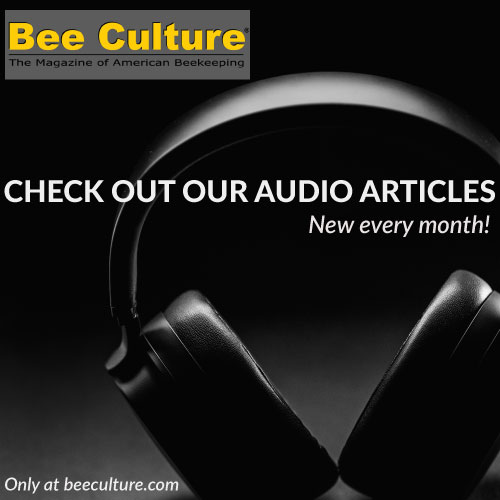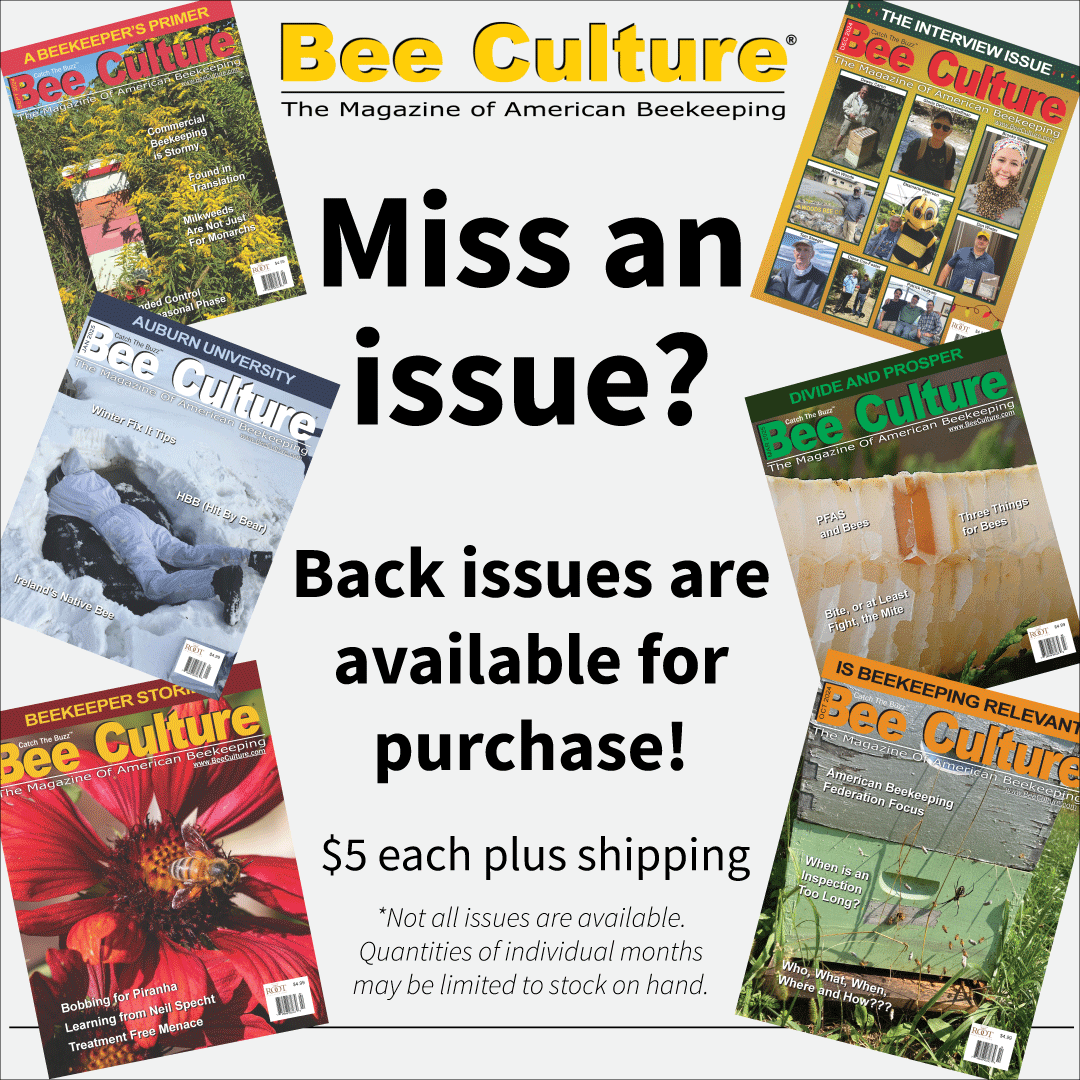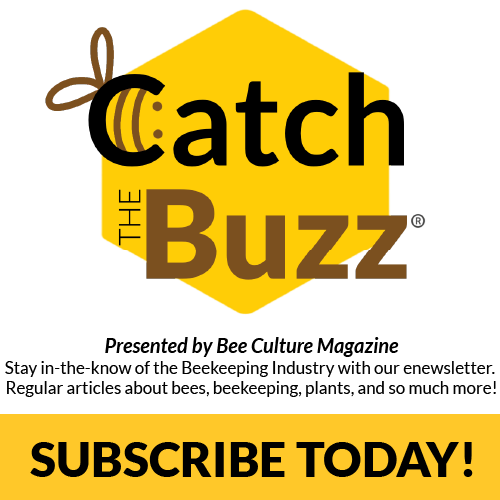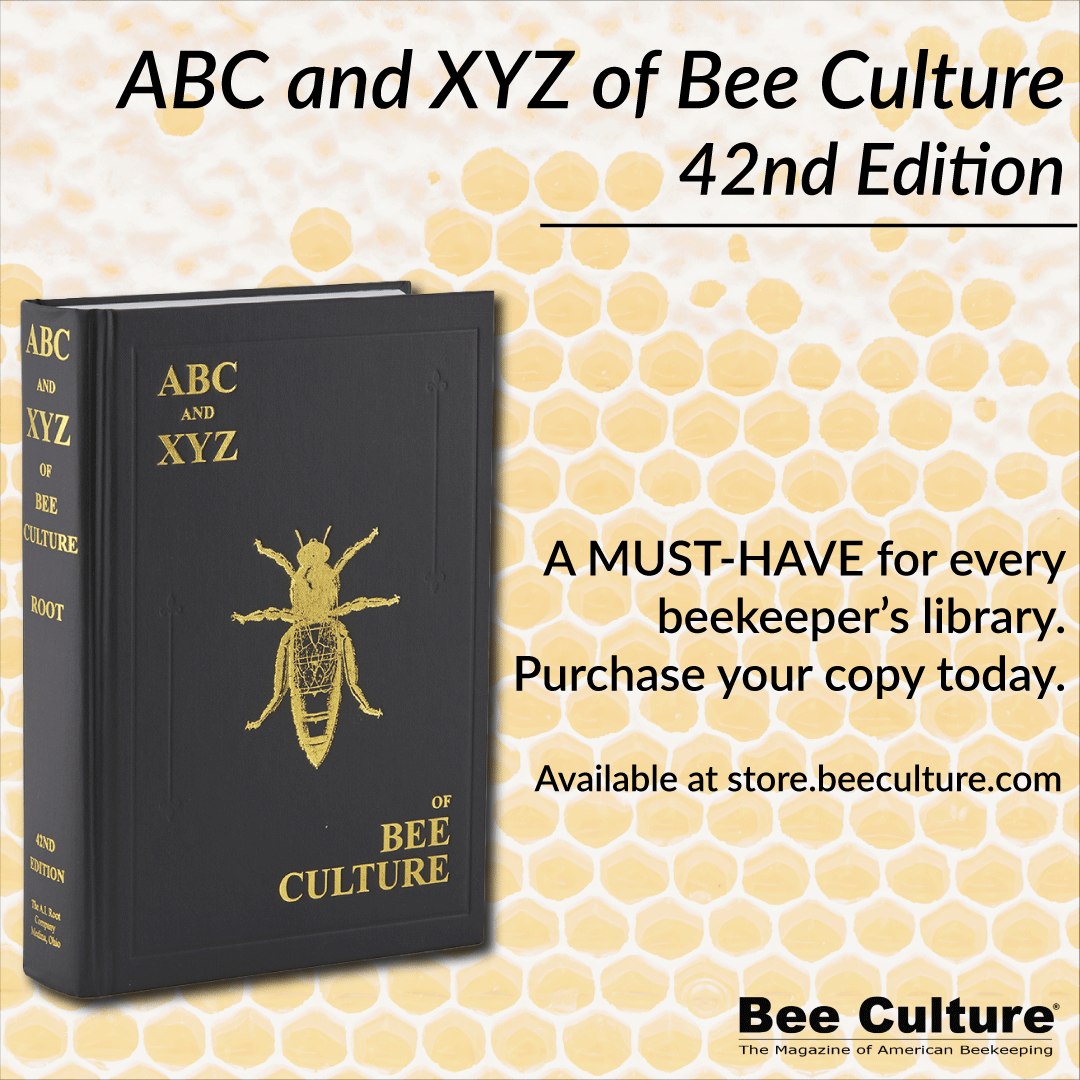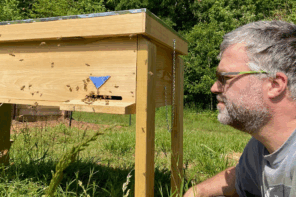Part 2
https://doi.org/10.55406/ABRC.6.25.2
This is the second part of the ABRC proceedings, including abstracts relating to Nutrition and Foraging, Physiology, Management and Breeding and Extension. Part 1, covering Pesticides, Pathogens and Parasites, Varroa and Hive Pests, was published in the previous issue of Bee Culture (Martin Ewert and Walsh, 2025).
Allyson Martin Ewertᵃ,ᵇ, Elizabeth M Walshᵃ
aUSDA-ARS Honey Bee Breeding, Genetics, and Physiology Research Unit, Baton Rouge, Louisiana, USA
bLouisiana State University AgCenter, Department of Entomology, Baton Rouge, Louisiana, USA
Topic: Nutrition and Foraging
Determining the impacts of climate change stressors on bee forage nutritional quality
Oral presentation
Baugus L, Rangappa RB, Chakrabarti P
Plant pollen and nectar contain all essential macro – and micronutrients for both honey bees as well as native bees. This study aims to evaluate the effects of climate change stressors on the nutritional quality of plant pollen and nectar, as well as the physiological changes in the plants. Sunflower plants were grown under stressed conditions, in order to determine how the nutritional quality of the pollen, nectar, as well as the plant physiology changed after stress exposure. During this study, sunflowers were grown under four different experimental groups consisting of heat stress, drought stress, combined heat and drought stress, as well as a control group. After the stress period, pollen and nectar were collected and assayed in the lab to determine its nutritional content, and plant physiology was monitored using a variety of methods.
Creating a phenology wheel for the Southeast region
Poster presentation
Green C, Fawley J, Eaton E, U’ren B, Gautam A, Lau P, Chakrabarti P
Beekeepers often choose habitat for bees without an understanding of the availability of floral resources that bees forage upon. Better understanding of floral resources would aid researchers in choosing the right habitat as they aim to strengthen bee populations, which are critical for agricultural production worldwide. The objective of this project is to create a database of pollen samples collected throughout the state of Mississippi that beekeepers and researchers can use to improve their knowledge of bee habitats. The database will show the phenology of numerous plant species. The project involves working with beekeepers as citizen scientists to obtain pollen samples from honey bee colonies every month. The samples are then color sorted and acetolyzed for plant identification. The long-term goal of the project is to capture the seasonal plant diversity across the region which can be good sources of pollen for all bee species.
A season tracking the foraging of 32,000 bees: applications for organic apiculture
Poster presentation
DeMoras BX, Peñaloza-Aponte DX, Brandt S, Dent E, Bruckner S, Underwood RM, López-Uribe MM, Urbina JV, McArt SH
Determining where honey bees forage in the landscape is critical to understanding colony-level patterns of pesticide exposure and floral resource utilization. Direct observations are impractical for monitoring thousands of individuals across multiple colonies, and existing automated tracking systems, like harmonic radar and radio frequency identification, use bulky tags that could affect flight behavior. In this poster, I describe the results of an experiment tracking honey bee foraging on organic farms using an automated Raspberry Pi and fiducial tag-based system first described in Penaloza-Aponte et al. (2024). We monitored the foraging activity of 32,000 bees across 36 colonies from mid-March to early September 2024. Our system identified over 58,000 foraging trips throughout the season. While analysis of these data is still in progress, we demonstrate the ability of this system to gather granular data on foraging activity across the entire seasons. Through ongoing work with collaborators, anticipated results will clarify foraging patterns of colonies placed on organic farms and help define standards for organic apiculture.
Sterol nutritional physiology in bees fed a multifloral pollen diet
Oral presentation
Gautam A, Whilden M, Lau P, Seshadri A, Chakrabarti P
A majority of flowers require pollinators to reproduce. About seventy percent of the flowering plants worldwide, including more than two-thirds of crops, depend on pollinators. Plants in return provide pollen and nectar to the pollinators as the main sources of their required nutrients. Pollen provides important nutrients for example proteins, carbohydrates, amino acids and phytosterols. Phytosterols are a type of lipids that play an important role in hormone production and various other physiological processes in insects including bees. The main objective of this study was to understand the nutritional physiology in two different bee species when fed pollen patties in a laboratory cage setting. The cage study was conducted for two weeks where honey bees and bumblebees were fed pollen patties made from a multifloral pollen source. Diet consumptions and survivals across all experimental groups were measured daily. A targeted lipidomics approach was done to quantify the sterols in the bees in addition to assessing other physiological parameters across the experimental groups.
Enhancement of a pollen substitute to promote honey bee health
Poster presentation
Ghimire S, Palmer J, Olden F
Honey bees (Apis mellifera) face several environmental challenges, among which poor nutrition is a significant threat. Previous research shows that commercial diets fall short compared to natural pollen regarding bee health. This study aims to enhance the dietary benefits of a pollen substitute on bee health by improving the manufacturer’s formulation with minimal investment. The feeding trials consisted of newly emerged bees distributed into five diet groups: 1) sucrose-only negative control (Control), 2) diet control, MegaBee prepared according to the manufacturer’s recommendation (MB), 3) MB in the presence of probiotic superDFM (MB/DFM), 4) MegaBee enhanced with invert sugar, Honey B Healthy, and Vitamin C (MB+), and 5) MB+ in the presence of the probiotic superDFM (MB+/DFM). During the 2-week experiment, samples were collected at various time points to measure body weight, whole-body protein content, and the expression of the nutrition-response gene, vitellogenin, and the immune gene, abaecin. Results indicate significant differences between different diet treatments in several health parameters, with MB+ positively impacting overall.
Exploring the impact of weather on bee foraging in soybeans using bioacoustic monitoring
Oral presentation
Hearon LE, Johnson RM
While pertinent to questions of pollinator protection, diel patterns of honey bee foraging have not been thoroughly studied for many crops. Even less is known about the interaction of weather effects with these daily patterns, yet we can reasonably expect weather to be a strong driver of foraging. Traditional methods such as sweep netting have been used to characterize diel foraging patterns, but they are rarely used with a temporal resolution finer than one hour and sampling is usually conducted in fair weather. Our lab has leveraged the emerging method of bioacoustics to conduct a number of experiments monitoring bee activity in soybean fields at a one-second temporal resolution. Here, we combine and re-examine these data to quantify the effects of temperature on honey bee foraging in the soybean system. We find that higher temperatures drive earlier foraging in soybean fields, but total foraging is unaffected. We interpret these results as supporting that soybean flowers open earlier in warmer temperatures and that temperature does not affect total flowering or nectar production.
Conservation agricultural management practices affect the nutritional landscape for pollinators
Oral presentation
Lau P, Abbate A, Tundo G, Mubvumba P, Rering C, Williams G, Seshadri A, Tyler H
Landscape development is changing the nutritional landscape for bees and has been attributed as one of the primary factors causing bee decline. However, farmers and land managers need to maximize agricultural production and have adopted various land management strategies to increase crop yield. This typically comes with declining soil health and biodiversity loss. To increase sustainability while maintaining crop productivity, conservation management practices are being explored to improving soil health and crop yield. These changes in soil structure and nutrition can affect plants and interacting organisms, creating a bottom-up effect across trophic levels. This includes the pollen and nectar from crops bees use as a resource with implications for understanding and improving bee health and nutrition. In this study, experimentally manipulated soil through reduced strip tillage and cover crop conservation practices to determine how this can ultimately affect the pollinator nutritional landscape. We found effects of cover cropping on the soil enzyme activity and nutrient levels on the soil surface and a reduced pollen protein content from cotton flowers on plots managed with cover crops. These results have implications on pollinator nutrition, health and conservation.
Enhancing honey bee immunity and longevity with microalgal feed additives
Oral presentation
Martin Ewert A, McMenamin A, Adjaye D, Rainey V, Ricigliano V
Microalgae feed additives, including spirulina (Arthrospira platensis) and Chlorella (Chlorella vulgaris) biomass, are emerging as beneficial feed ingredients for livestock, including managed honey bees (Apis mellifera). These microalgae provide abundant essential amino acids, lipids and other nutrients that are bioavailable to bees, supporting their growth and physiology. Immunomodulatory effects of microalgae have been demonstrated in other animals, but this has not yet been substantially explored in honey bees. We investigated the impacts of microalgal feed additives on honey bee immunity and longevity. Caged bees were fed a control artificial diet, or the same diet supplemented with pollen, spirulina or Chlorella. Gene expression and longevity were measured following six days of ad libitum feeding. Both spirulina- and Chlorella-fed bees lived longer than controls. Spirulina-fed bees exhibited significantly higher expression of several antimicrobial peptide-encoding genes and had superior bacterial clearing ability when challenged by injection with live E. coli cells. We propose that this observed increased immunocompetence is at least partially due to elevated AMP levels. Our findings indicate that spirulina can support greater honey bee health and immune function with no apparent health costs when added to supplemental feed. However, more work is needed to understand these effects in a field-realistic setting. Overall we propose that spirulina has potential as a functional feed additive to better support honey bee resilience in the context of modern beekeeping.
Effects of diet and probiotic on the microbiota of honey bees
Poster presentation
Palmer J, Olden F
Honey bee (Apis mellifera) colony survival and health relies on pollen for proteins, lipids and micronutrients. Pollen intake influences lifespan and several health metrics, including physiological metabolism, immunocompetence, disease tolerance and resistance to pesticides. Although the nutritional value of pollen substitutes is not fully known, beekeepers use these products to mitigate pollen shortages or boost colony productivity. Recently, probiotics have been introduced to enhance bee health by improving their gut microbiome, aiding digestion, disease resistance and nutrient utilization. Similar to pollen substitutes, the benefits of probiotics are not well-documented to confirm their importance in beekeeping. In this study, we performed a comparative analysis of pollen and pollen substitute diets in combination with a probiotic. Feeding trials were conducted to measure the effect of such combinations on the gut microbiota using 16S sequencing. Our results indicate that diet has a significant effect on bacteria diversity and abundance in the midgut, and that probiotics may offer benefits when combined with a pollen diet.
The impact of supplemental feeding on honey bee foraging habits in carrot seed
Oral presentation
Reed R, Hopkins BK
Honey bees (Apis mellifera) are the most widely used agricultural pollinator but are far from perfect. Foraging honey bees transferring pollen between fields is a substantial concern for producers of carrot (Daucus carota) seed and other insect pollinated seed crops. This study tested the impact of supplemental in-hive feeding on the foraging behavior of honey bees in a carrot seed field. Entrance activity monitors, and pollen samples were used to track foraging activity and pollen composition. These results of this study showed that supplemental feeding did not significantly impact foraging behavior in this system. While this did not solve the intended challenge, these findings demonstrate that beekeepers can feed colonies during this nutritionally poor period without negatively impacting pollination.
Topic: Physiology
An exploratory analysis of gene expression stressors in the behavioral & physiological mechanisms
of Apis mellifera foragers
Oral presentation
Cano I, Tung GA, Hawkings C
Apis mellifera, the European honey bee, is an introduced yet impactful bee species within North America. Pollinating a high percentage of agricultural crops and native plants, their coexistence with humans is imperative. As highly eusocial insects, their behavioral and physiological characteristics are essential to the wellbeing of their colonies, and disruptions to their environments can be detrimental. In nutritionally homogeneous environments, foragers may become nutritionally stressed due to lack of macronutrient variety. The objective of this study is to identify which genes respond to differences in macronutrient availability and may in turn inform foraging decisions based on nutritional context. In this study we utilized publicly available RNASeq data to compare gene expression profiles of foragers exposed to differing diets. This analysis can provide insight into how foraging honey bees are affected by environmental stressors that directly impact their behavior and ultimately their ability to be effective pollinators.
A juvenile hormone mimic positively influences colony growth in a field setting but decreases
nursing competency in the laboratory
Oral presentation
Fine JD, Litsey EM, McAfee A, Lamas ZS
Previously, we demonstrated that indirectly exposing queens to a juvenile hormone (JH) mimic can positively influence aspects of queen fecundity in a laboratory setting. We have now completed an experiment examining the effects of the same JH mimic on the health, longevity and size of colonies in a field setting and performed laboratory experiments to characterize effects on other aspects of colony reproduction. Curiously, we found that the JH mimic positively influenced late season and early Spring colony populations, but in a laboratory setting, the offspring of queens treated with the JH mimic performed less competently as nurses. This presentation will discuss these results along with the results of proteomic comparisons made between treated and untreated queens and between their worker offspring. Possible causes for the discrepancy between lab and field results will be discussed, and future avenues of research that will lead to novel tools to promote queen fecundity will be identified.
The influence of juvenile hormone on the expression of a major royal jelly protein in Apis mellifera
Oral presentation
Hayat J, Hawkings C
The reproductive ground plan hypothesis (RGPH) has identified several genes, proteins and hormones that have been repurposed to suit the social organization in a colony. Honey bee workers experience age polyethism, where they transition from nursing tasks to foraging tasks. Unlike reproductive individuals, juvenile hormone (JH) in sterile workers acts as a pacer for age polyethism that triggers foraging behavior and other task-related physiological changes. High JH titers are associated with expression of nutritionally linked genes and in this study we sought to identify candidate genes that fit into the RGPH. Our first objective was to conduct an exploratory transcriptome analysis to identify nutritionally linked genes between the brains of nurses and foragers, and differential gene expression analysis revealed 89 differentially expressed genes between the two. Bioinformatic analysis was used to identify the gene of interest, major royal jelly protein 1 (mrjp1), which is expressed higher in nurses than foragers. The gene is associated with the synthesis of royal jelly and gene annotation revealed that major royal jelly protein 1 (mrjp1) could be correlated with hormonal titers. Bioassays involving topical applications of JH analogs were used to determine the influence of JH on the expression of mrjp1. Our interest in JH stems from the use of its analogs in pesticides, so we aim to apply our methods to bettering conservation practices in addition to furthering our understanding of foraging behavior and the physiological factors that influence it.
Investigating the interplay between Apis mellifera hemocytes to infection
Oral presentation
Oeth M, Deepak Kumar D, Goblirsch M, Alburaki M, Adamczyk J, Karim S
Hemocytes, or immune cells, are integral components of the honey bees innate immune system with a notable role in defining the innate defense to infectious agents. Evidence suggests that infection drive substantial changes in hemocyte phenotypes, including proliferation, immune activation and differentiation, which directly and indirectly influence pathogen infection outcomes. Honey bee cellular immunity is primarily a neglected and unexplored field of science. In this study, a combination of pharmacological and molecular tools was utilized to investigate the functional role of bee hemocytes in microbial infection. Clodronate liposome (CLD) was used to deplete phagocytic hemocytes and elucidate their role in immune response and survival against Staphylococcus aureus, and Escherichia coli infection at varying temperatures. Hemocyte counts, hemolymph volume, survival and target gene expression were tracked over seven days. CLD-treated bees showed significant reductions in survival, hemocyte counts and hemolymph volume, particularly at 32°C and under the E. coli and S. aureus challenge. The findings emphasize the critical role of hemocytes in honey bee survival, with granulocytes and plasmatocytes being disproportionately affected by stressors. Together, these results represent a significant advancement in our understanding of the basic biology of bee hemocytes and their role in the bee immune response.
Defective drones: How ploidy and sex impact mutagenesis in the honey bee
Oral presentation
Shultz RR, Harpur BA
Mutation rate variation may have significant impacts on patterns of evolution. Factors that diminish the ‘randomness’ of mutations include the sex and ploidy of an organism. Sex-biased mutation has important implications for fitness: male vertebrates often accumulate and pass on more mutations to their offspring than females. The faulty male hypothesis states that male chromosomes may be less protected than female chromosomes. This hypothesis has yet to be tested in a haplodiploid invertebrate model. The honey bee provides a unique system to explore sex-biased mutation given that they are haplodiploid and undergo differential reproduction compared to a typical vertebrate model. Here we designed a series of experiments to evaluate mutation accumulation and response on a tissue and individual scale. Are male chromosomes more fragile than reproductive females? Are tissue types differentially susceptible to mutation? To address these questions, we used a mutagen to induce oxidative damage in honey bee drones and queens. We assessed mutational resilience through gene expression comparison. Our preliminary data suggest that there is variable individual response to abiotic stress. These results provide groundwork to understand the biochemistry behind male-biased mutations and offer further insight into the impacts on reproduction and colony health.
Love it or hate it? How honey bees respond to virus in food
Oral presentation
Simone-Finstrom M, McCarthy J, Walsh EM, Payne A
Viruses are nearly ubiquitous among and within honey bee colonies, but can vary based on season and the presence of particular vectors and stressors. Largely single-strand RNA viruses, they can be transmitted sexually, vertically, horizontally, through vectors and even through shared food resources. More information about bees’ ability to detect viruses at feeding sites is needed to understand their potential spread in the environment. In a series of experiments, caged honey bees were given a choice of two sucrose solutions, one treated with various field-relevant doses of virus (deformed wing virus (DWV), black queen cell virus or chronic bee paralysis virus) and one without virus. Honey bees showed context-dependent choices for the viral-laced sucrose, depending on viral type, dose and season in the laboratory. For example, bees exhibited some preferences for viral solutions in Fall, but in Spring they avoided viral solutions or showed no preference. A field-preference assay corroborated the Fall preference for a high dose of DWV in open foraging conditions. The mechanisms involved are currently being explored and remains unknown, but based on these data, we conclude that honey bees can detect viruses in a food source and given the conditions may be attracted them.
Transcriptomic analysis of Apis mellifera hypopharyngeal glands in varied temperatures
Oral presentation
Sullivan EJ, Tung GA. Hawkings C
The European honey bee, Apis mellifera, exhibits valuable pollination services in a variety of environments acting as a generalist pollinator. The species has been used to support agriculture in a variety of climatic regions and additionally has been a model for phenotypic flexibility most notably exemplified through age polyethism. The hypopharyngeal glands of Apis mellifera are of particular interest as they are responsible for secretion of royal jelly that is fed to larvae and queens, supporting bee and colony health. The objective of this research was to identify differential gene expression in the hypopharyngeal glands of Apis mellifera at varying temperatures. We used publicly available read data to compare transcriptome wide gene expression across 3 temperatures. The results of this study may have implications for crop health and future honey bee management in cross regional pollination services, as well as, honey bee health in the face of a changing climate.
Topic: Management and Breeding
A colony health and economic comparison between mite resistant and commercial honey bees
Oral presentation
Avalos A, Walsh EM, Bixby M, Card A, Card W
Honey bees (Apis mellifera L.) are the premier agricultural pollinators with direct ecological value and are key to some agro-economies. Major factors have negatively impacted honey bee health in the past 2 decades with Varroa (Varroa destructor, Anderson and Trueman) infestation rising as a principal predictor of colony mortality. A key strategy deployed in Varroa management is breeding for resistant honey bee populations that can maintain comparable levels of productivity as nonresistant populations. In this study, we examine one such population, Hilo honey bees, within the context of a common garden contrast with a commercial population in a stationary honey production operation. We compare colony survival, health, yield and profit outcomes to show how this specific breeding population retains a profit value in honey production operations while maintaining higher survival and lower Varroa infestation levels than the commercial population. This information can be used by commercial beekeepers to make best management practice decisions and inspire further work examining what trade-offs, if any, are present in this Varroa-resistant population.
3D thermographic analysis of temperature variations in bee hives: Insights into cluster dynamics
and bee health
Oral presentation
Dhungel A, Webster T, Maiti R, Shen C, Puerto K, Acharya S, Joshi Y
Honey bee colonies face significant challenges during Winter, particularly in maintaining optimal thermal conditions critical for survival. To address this, we developed a real-time temperature monitoring system comprising 20 temperature sensors strategically positioned within a bee hive. Temperature readings were recorded at 30-minute intervals and stored on an SD card for analysis. This non-invasive setup ensured minimal disturbance to the hive while enabling continuous monitoring. The collected data from 2023 were visualized using 3D thermographic models, providing a detailed spatial representation of temperature variations within the hive. The results revealed distinct thermal gradients, with higher temperatures concentrated in the brood region, indicative of active thermoregulation, while peripheral zones exhibited lower temperatures. Interpolated graphs and raw sensor readings offered comprehensive insights into both general thermal trends and localized fluctuations. The findings highlight the critical role of bee clustering behavior in maintaining hive thermodynamics, particularly during colder periods. Denser thermal clusters, associated with elevated temperatures, were linked to higher bee activity and improved hive health. This research underscores the potential of sensor-based monitoring systems to enhance beekeeping practices by providing actionable insights into hive conditions and bee behavior.
Are honey bees selected for Varroa resistance also resistant to pathogens?
Oral presentation
Dyrbye-Wright I, Simone-Finstrom M, Spivak M
Most honey bee (Apis mellifera) breeding programs focus on propagating colonies that are resistant to Varroa destructor. It has not been tested if lines selected for Varroa resistance are also disease resistant. We explored the relationship between honey bee resistance to Varroa and the pathogen Ascosphaera apis (chalkbrood disease). Over two years (2023 and 2024) and in two locations, we compared colonies from the POL-line (selected for Varroa resistance) to commercial colonies (Comm) that were not selected for Varroa resistance but were selected for hygienic behavior via the freeze-killed brood (FKB) assay. We inoculated colonies with chalkbrood then quantified signs of mites, disease and hygienic behavior. Results indicate that the POL-line had significantly lower mite loads in two of three trials and cleared chalkbrood infection as effectively as Comm. In two trials, POL and Comm colonies had similarly high levels of hygienic behavior, while in the third trial POL colonies had significantly lower hygienic behavior yet removed chalkbrood as effectively as Comm colonies. The results indicate that the POL-line demonstrates relative resistance to both mites and chalkbrood not fully predicted by hygienic behavior based on FKB. Further research is needed uncover other mechanisms that contribute to resistance in honey bees.
Colony hospitality and the dynamics of drifting drones
Oral presentation
Gilchrist IR, Harpur BA
Nestmate recognition has been vital to the success of eusocial organisms, but drones seem to evade colony nestmate recognition mechanisms. Up to 89% of the drones in a colony can be drifters originating from other colonies. Our research investigates drone-worker interactions and the dynamics of drone drift. Previously we demonstrated that workers evaluate the quality of drones and will target and evict small or immune-stimulated drones. Our current research examines the role of drone choice in drift by comparing drones in colonies of different conditions. We hypothesized that colony state (queenless and queenright) affects how hospitable a colony is to drones, and that colonies more favorable to drones will accumulate more drifted drones. To determine colony hospitality, we used observation colonies to measure aggression and trophallaxis in queenright and queenright colonies. We paired this with a common garden experiment where drones were placed into a control colony, a queenless colony, a colony with limited worker interaction, and a hive with food but without workers. Over seven days, we tracked the number of drones in each colony to determine where drones drift. Our results highlight the importance of drone choice and differences in colony hospitality on where drones drift.
Effects of screened bottom boards on honey bee colony thermoregulation in Summer
Poster presentation
Williams R, Purtee C, Stolhand D, Grace C, McPhee M, Wellons D
We examined the impact of screened bottom boards on the temperature and humidity at the edge of the brood nest in honey bee colonies during the Summer. Using open and closed conditions, we compared the magnitude of fluctuations within each hive over time, and found that in 8 of the 9 apiary locations tested, at least one element (temperature or humidity) remained more stable when the hives had their bottom boards closed off from the elements during hot Summer conditions. These findings suggest possible advantage to solid bottom boards that should be considered, and they highlight the importance of accounting for humidity when studying bees’ methods for maintaining ideal brood nest conditions.
Topic: Extension
Australia’s Plan Bee Breeding Manual underpins estimated breeding values for queen bees
Oral presentation
Frost EA, Alexandri R, Chapman NC, Noordyke E, Banks R, Walkom S, Bunter K
Australia’s National Honey Bee Genetic Improvement Program, Plan Bee, was the nation’s first breeding program to implement modern breeding tools and gain the financial support of pollination-dependent industries. Plan Bee developed a nationally representative reference population, standardised trait definitions, selection criteria relevant to Australia, pedigree and performance recording spreadsheets, a national database to house beekeepers’ data and facilitate analyses, and reports to beekeepers on genotypic and phenotypic analyses which resulted in the first Estimated Breeding Values (EBVs) for Australian bees. EBVs unlock the potential for modern animal breeding, however, require sufficient quality and volume of standardised pedigree, performance and environmental data for their estimation. The Plan Bee Breeding Manual: Second edition has been developed to help queen bee breeders implement modern breeding in their enterprises and improve the genetics of Australia’s honey bee population, giving them the tools required to access EBVs for their queens. The manual outlines modern breeding principles, performance data recording using a standardised national approach and submitting that data to the Plan Bee database and contains easy-to-use, downloadable recording sheets and checklists. A trait dictionary is included, which removes ambiguity and reduces or eliminates subjectivity when recording data, and additionally covers Varroa tolerance and resistance traits.
Queen fertility to Emerging Threats: Project Apis m. funded projects
Oral presentation
Guarna MM
Project Apis m.’s (PAm) mission is to drive science to deliver innovation for healthy bees and bee businesses. With over $12 million invested in research projects and extension programs, PAm is dedicated to addressing unmet industry needs. This presentation will provide an overview of the projects supported by PAm to advance science with actionable outcomes. As an example, we will describe projects on queen health, the effect of temperature on queen fertility and colony performance and a novel non-destructive method to assess queen health. We will also highlight other focus areas including pollination and bee health and emerging threats. We will discuss how to access PAm funding and resources, including practical guides and the recently released training videos on the global distribution, detection, and management of the Tropilaelaps mite, an emerging pest moving west. We will discuss PAm’s programs to support researchers and scholars and describe the proposal submission and review processes including the key role played by the Scientific Advisors and by PAm’s Board of commercial beekeepers.
Emergency response to transportation accidents involving honey bees
Oral presentation
Heck A, Milbrath M
Michigan State University Extension’s (MSU Extension’s) Animal Agriculture Team developed the Emergency Response to Accidents Involving Livestock program in 2018 to train first responders to deal with livestock transportation accidents. The program includes hands-on training sessions, online resources, and emergency response trailers throughout the state that contain response equipment. In 2023, the team added honey bees to the program to address the diversity of Michigan’s agriculture industry. Many first responders who attend training sessions on honey bees express they had never thought about honey bee hives on roadways or how to respond to an accident involving honey bee colonies. MSU Extension explains to first responders how common it is for honey bee colonies to be transported throughout Michigan and teaches them how to respond to an accident, minimize stings, prevent a stalled load from overheating and contact migratory beekeepers to respond. MSU Extension’s Emergency Response to Accidents Involving Livestock program is an example of successful cross-species programming. These successes are supported by evaluation data, funding support, stakeholder feedback and effective responses to transportation accidents involving livestock. The program aims to protect the safety of first responders and the public, promote animal welfare and support agriculture producers, including beekeepers.
Five-year update on Alberta’s Colony Health Monitoring project
Oral presentation
Labuschagne R, McCormick N, Olson E, Panasiuk A, Muirhead S, Phillips C
The Tech Transfer Program’s Colony Health Monitoring (CHM) project delivers a comprehensive evaluation of honey bee health across Alberta, Canada, with the goal of supporting sustainable beekeeping practices and improving colony health outcomes. From 2020 to 2024, the CHM project monitored key parasites and pathogens — including Varroa destructor, Vairimorpha spp., Paenibacillus larvae, Melissococcus plutonius, and honey bee viruses (DWV, VDV, CBPV, BQCV, SBV) – through seasonal sampling in Spring, Summer and Fall of an average of 197 apiaries annually across Alberta’s five beekeeping regions. In addition to colony-level assessments of Varroa mite infestations and apiary-level analyses of pathogens and viruses, the CHM project also evaluated Varroa resistance to amitraz and collected honey and pollen samples for pesticide residue analyses during two of the five years. These efforts enable both temporal and spatial tracking of disease trends and emerging risks to colony health. This presentation will summarize key findings from five years of monitoring, emphasizing trends in parasite and pathogen prevalence and interactions among pathogens. Findings from the CHM project inform best management practices by identifying seasonal and regional patterns of parasite and pathogen prevalence. These outcomes highlight the critical role of sustained monitoring in addressing emerging threats and advancing sustainable apiculture in Alberta.
Approaches to improving honey bee health in California
Oral presentation
Niño E
Honey bees remain the primary managed pollinator used for pollination of dozens of California crops. However, beekeepers face high losses due to a number of biotic and abiotic stressors impacting honey bee health including colony and crop management during pollination. In my lab we develop and evaluate strategies to minimize potential harm to honey bees in a holistic manner. These include approaches to manage Varroa mites, improve nutrition opportunities, understand crop pollination needs, as well as provide technology transfer to relevant stakeholder groups.
ABRC Extension Award report: Drone workshop
Oral presentation
Underwood R, Anton K
Outreach and education programming about queen rearing generally either excludes any learning about drones altogether or mentions them only briefly. However, drones contribute an inordinate amount to the success of the production of mated queens. Thanks to ABRC Extension Award funding, a workshop all about drones was conducted at Penn State University. Not only did this workshop enhance the knowledge of the participants, it served as a pilot for future workshops. During the 2-day in-person workshop, participants engaged in apiary activities including marking drones and assessing drifting, demonstrations of how to purposely rear drones and discussions about feeding colonies for proper nutrition. Participants also engaged in laboratory activities including drone eversion, semen collection and practice measuring mite biting and Varroa sensitive hygiene traits. The highlight of the workshop was an afternoon spent searching for drone congregation areas. This talk will describe the workshop and provide information about how it changed the mindset and behaviors of participants.
Leveling Up: A beekeeping business program
Oral presentation
Vu A, Bammer M, Athearn K, Morgan K, Ellis J, Jack C, Diaz J
In 2023, a cohort of 30 Florida beekeepers were selected to participate in the “Leveling Up” beekeeping business program run by the UF/IFAS Honey Bee Research and Extension Lab. Leveling Up is a two-year project aimed at helping this cohort transition their beekeeping hobby into a sideline or full-time business. This work is funded by a US Department of Agriculture, National Institute of Food and Agriculture, Beginning Farmer and Rancher Development Program grant. Although this program is ongoing, to date we have completed significant work towards two of the grant’s main objectives: at the end of the program, at least 75% participants will create 1) a 3-year business plan and 2) at least 2 new honey bee value-added products. This presentation will share an overview of this program, its objectives, structure and timeline, will provide a report of participant progress at the program’s halfway mark and will discuss how the program has been able to adapt to participant needs in real time.
References
Martin Ewert A & Walsh E M. 2025. ABRC 2025 Proceedings: Part 2. Bee Culture June 2025, Volume 153, Issue 6, pp. 36-43. https://doi.org/10.55406/ABRC.6.25.2

